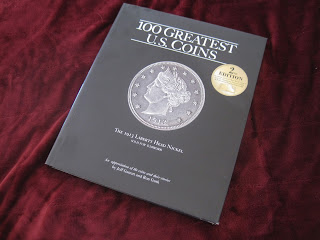I recently made the acquaintance of a young man who works at a local business, and he expressed an interest in coins after learning that I am an avid collector. Lately, each time I see this fellow, he either asks me what I have that is "new", or he entertains me with a story of some numismatic item that he found.
I remember being surprised by his interest, since I thought that everyone his age was infatuated with high-tech "toys", and had no interest in "old school" hobbies like collecting. I decided to try to inspire this kid, by gifting a few numismatic books to him.
The first gift was the modern classic "100 Greatest U.S. Coins" by Jeff Garrett and Ron Guth. I just happened to obtain a duplicate copy of the 2nd edition, and the intent of the gift was "shock & awe", at both the beauty and the value of some of our finest coins.
Next, after we had a discussion about mint-marks on Mercury dimes, I gave the young man two different books. First, an early edition of "A.N.A. Grading Standards" (I purchased a newer edition for my own use). Second was an earlier edition of "The Cherrypicker's Guide To Rare Die Varieties" by Bill Fivaz and J.T. Stanton. These two books have a lot of practical value for a new numismatist.
I began to reminisce about my own beginnings with numismatic literature.
My interest in U.S. coins began to stir in the late 1980's. I occasionally visited the retail coin shop of Steve Estes PN. Steve kept a stock of coin books for sale, and the first one I spent real money for was another classic: "The History of United States Coinage as Illustrated by the Garrett Collection" written by Q. David Bowers, who is one of the preeminent numismatists of our time (and a prolific author) . Dave wrote this book as a tribute to the famous Garrett family collection at the time of the collection's sale (by his firm, Bowers & Ruddy). The collection had been donated by the Garrett family to the Johns Hopkins University in Baltimore, MD, and board of Johns Hopkins made the decision to sell.
This volume remains one of the keystones to my numismatic library, and I can still recommend it as a good way to learn about U.S. coinage and one of America's earliest and most devoted collectors, T. Harrison Garrett. I remember being enthralled by the image of the Garrett family home (known as Evergreen House) in north Baltimore, and the thrill of actually visiting Evergreen House and taking the tour over 15 years later.
My next big numismatic literature purchase was "Walter Breen's Complete Encyclopedia of U.S. and Colonial Coins". As the title implies, this was an ambitious effort to cover (in great detail) the colonial coinage of the early U.S. (ie. prior to the establishment of the U.S. Mint and commencement of coin production in 1793), all the regular-issue U.S. coinage (plus proof and commemorative issues), and even much of the private & territorial coins of the U.S. Breen supplemented his encyclopedic understanding of each series with amusing (and occasionally factual) anecdotes concerning the production and/or the collecting of particular coinage issues. Breen's work covered the important types for each series, while leaving the exhaustive variety-by-variety analysis to other authors. By that time, I had become involved in collecting large cents, and it was Breen who informed me about some of the important cent hoards and accumulations (eg. The Nichols Find and the Randall Hoard) and the fact that some coins are important enough to have names of their own (eg. "THE COIN", which refers to a particular 1793 Chain Cent).
Sunday, April 16, 2017
Subscribe to:
Post Comments (Atom)






No comments:
Post a Comment